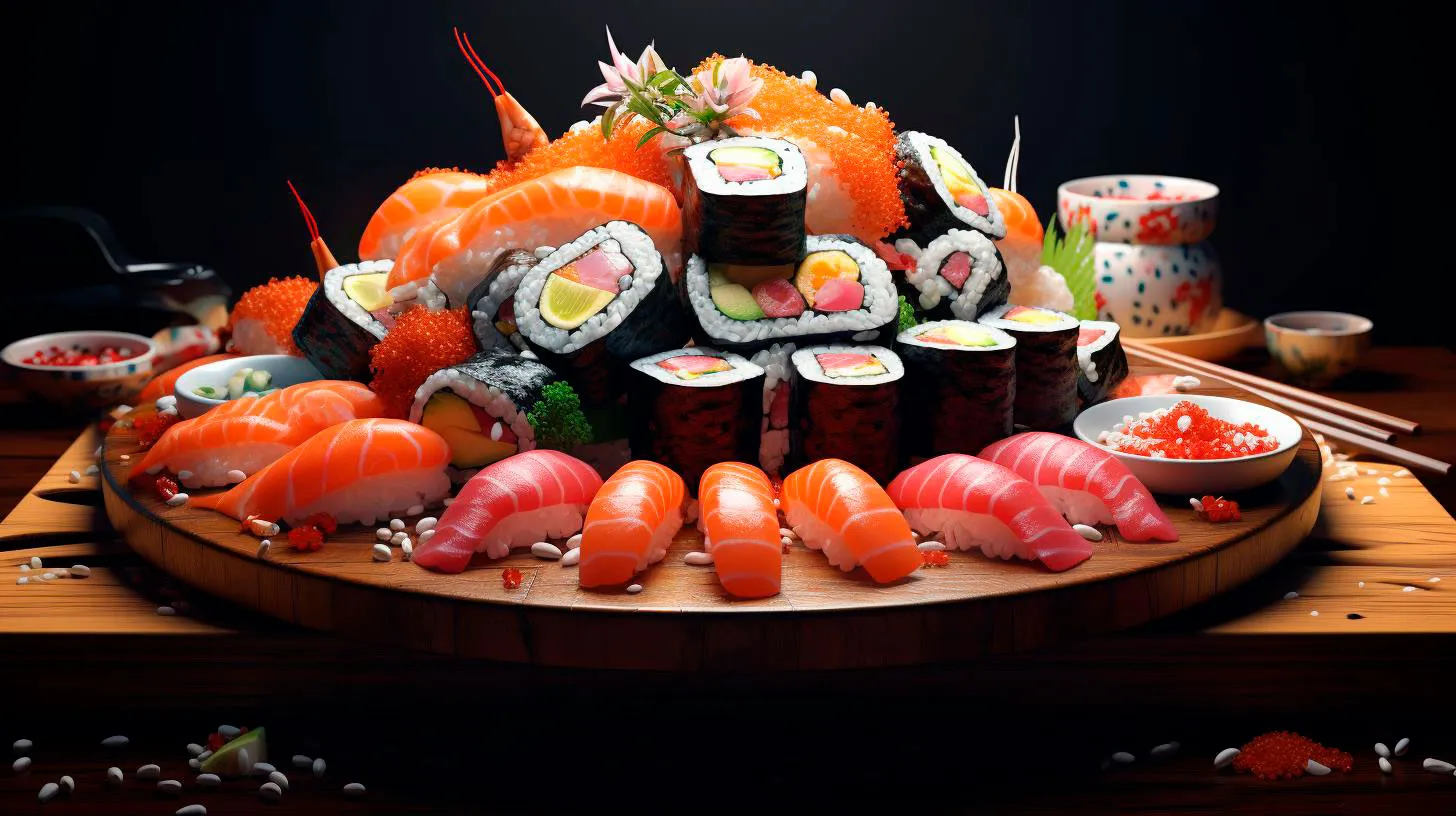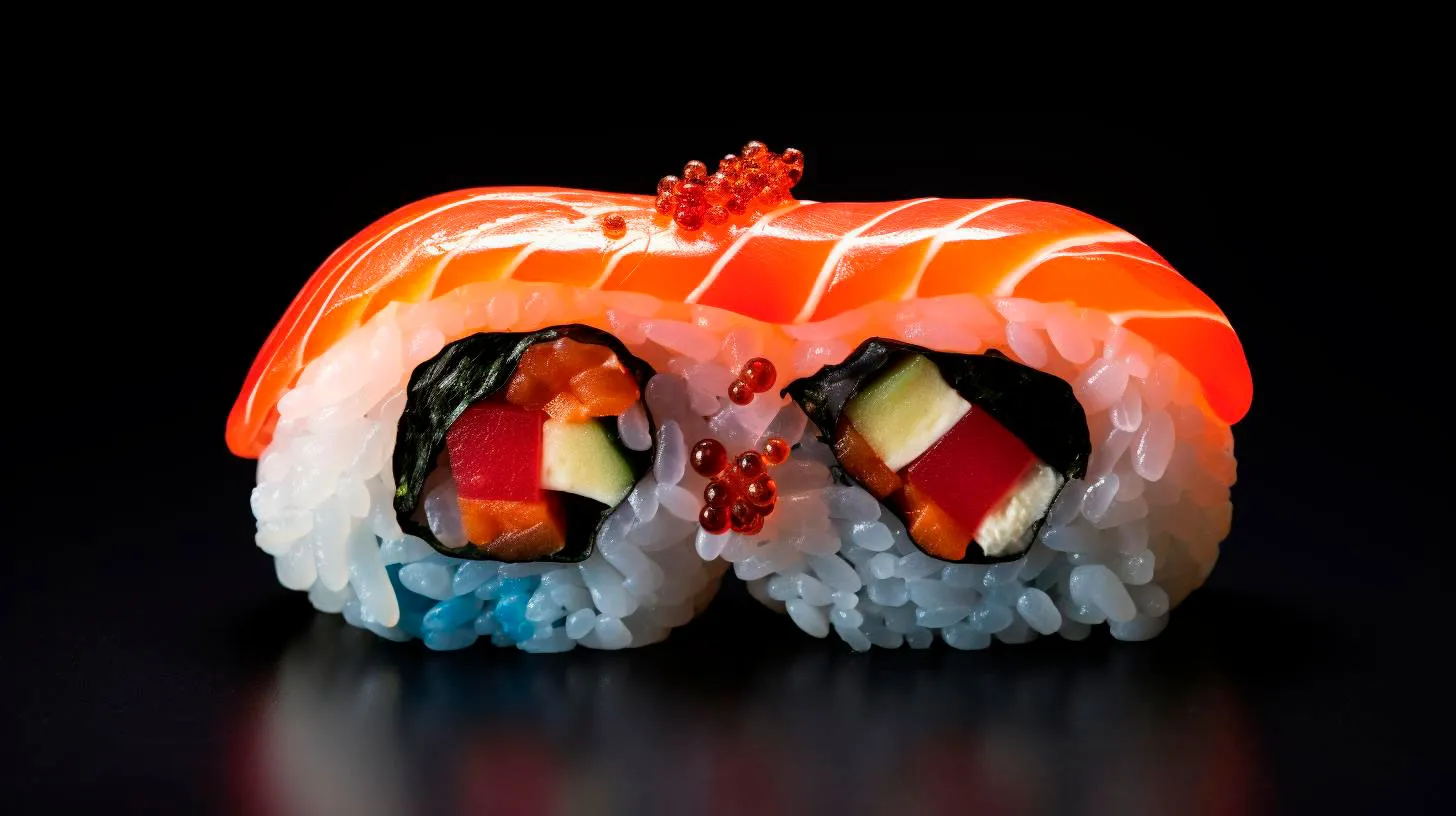Eco-Friendly Sushi Restaurants Embracing Sustainable Practices
In this article, we will explore how sushi restaurants are prioritizing sustainability and the advantages of patronizing these environmentally responsible establishments.
The Rise of Sustainable Sushi Restaurants
Sushi has gained immense popularity in recent years, becoming a global culinary sensation. However, the rapid growth of this industry has raised concerns about overfishing and unsustainable fishing practices. To address these issues, sushi restaurant owners and chefs are adopting sustainable practices to ensure the longevity of their businesses and the preservation of marine ecosystems.
Key Sustainable Practices
Sustainable sushi restaurants focus on several key practices to minimize their environmental impact:
- Sourcing sustainable seafood: These restaurants work closely with suppliers who adhere to sustainable fishing practices. They prioritize seafood that is certified by programs such as the Marine Stewardship Council (MSC) and the Aquaculture Stewardship Council (ASC).
- Reducing food waste: To minimize food waste, sushi restaurants implement effective inventory management systems and train their staff to portion ingredients appropriately. They also work with non-profit organizations to donate excess food.
- Using eco-friendly packaging: Many sustainable sushi restaurants avoid single-use plastics and instead opt for biodegradable or compostable packaging materials. This helps reduce the amount of waste that goes into landfills and oceans.
- Energy-efficient operations: Utilizing energy-efficient appliances, LED lighting, and implementing recycling programs are a few examples of how sushi restaurants are minimizing their energy consumption and carbon footprint.
- Supporting local and organic farming: Some sushi restaurants prioritize locally sourced and organic ingredients. This reduces pollution caused by long-distance transportation and supports local economies.
The Advantages of Dining at Eco-Friendly Sushi Restaurants
Patronizing eco-friendly sushi restaurants not only supports sustainable practices but also comes with several advantages for both customers and the environment:
- Healthier food options: Sustainable sushi restaurants often emphasize the use of high-quality, fresh ingredients. This means customers can enjoy healthier, nutrient-rich meals that are free from harmful additives and chemicals.
- Improved taste and dining experience: By sourcing sustainable seafood, these restaurants ensure the freshness and flavor of their dishes, enhancing the overall dining experience for customers. Additionally, the eco-friendly ambiance adds a unique touch to the restaurant’s atmosphere.
- Supporting ocean conservation: By choosing sustainable seafood, sushi restaurants contribute to the preservation of delicate marine ecosystems. This helps protect endangered species and maintain the balance of underwater habitats.
- Community engagement: Sustainable sushi restaurants often collaborate with local organizations and hold educational events to raise awareness about ocean conservation and sustainable dining. By dining at these establishments, customers become part of the movement towards a greener future.
Statistics and the Future of Sustainable Sushi
The importance of sustainability in the sushi industry becomes evident when considering the following statistics:
- According to the UN Food and Agriculture Organization, over 30% of the world’s fish stocks are being overfished.
- The Marine Stewardship Council reports that approximately 9% of global fish catches are certified as sustainable.
- Research shows that sustainably caught seafood is projected to increase by 70% by 2030, reflecting the growing demand for eco-friendly dining options.
With the increasing awareness of sustainability and the growing demand for environmentally responsible choices, the future of eco-friendly sushi restaurants appears promising. By supporting these establishments, individuals can enjoy delicious sushi while actively participating in the preservation of our oceans.
Eco-friendly sushi restaurants are paving the way for a more sustainable future in the food industry. Their commitment to sustainable practices, sourcing, and packaging is not only beneficial for the environment but also for customers who seek healthy and tasty dining experiences. So, the next time you crave sushi, consider choosing an eco-friendly sushi restaurant to indulge in your favorite dish guilt-free.
The Impact of Sushi Demand on Marine Ecosystems
In this article, we will explore the effects of sushi demand on our oceans and discuss potential solutions to mitigate these environmental concerns.
The Rising Tide of Sushi
Sushi has skyrocketed in popularity over the past few decades. With its origins in Japan, it has now become a global phenomenon, with sushi restaurants popping up in nearly every major city. According to recent statistics, the sushi market is expected to reach a value of $22.4 billion by 2024, growing at a compound annual growth rate (CAGR) of 4.1%. This surge in demand has put immense pressure on marine ecosystems, particularly the fish populations targeted for sushi ingredients.
The Unsustainable Fishing Practices
One of the key concerns related to sushi demand is the unsustainable fishing practices employed to meet the requirements of the sushi market. Overfishing, where fish are captured at a rate faster than they can reproduce, has become rampant due to the high demand for certain species of fish. This has led to a decline in fish populations and disrupted the delicate balance of marine ecosystems.
Furthermore, destructive fishing methods such as trawling can cause significant collateral damage to marine habitats. Trawling involves dragging nets along the ocean floor, resulting in the destruction of coral reefs and other essential habitats that support marine life. It is estimated that trawling affects approximately 40 million square kilometers of seabed annually.
The Devastating Consequences
The impact of sushi demand on marine ecosystems is far-reaching and has several detrimental consequences:
- Depletion of Fish Stocks: Overfishing driven by sushi demand has led to the decline of numerous fish populations, pushing some species to the brink of extinction. This not only threatens biodiversity but also disrupts the food chain within marine ecosystems.
- Loss of Marine Habitats: Destructive fishing practices have ravaged essential habitats such as coral reefs and seagrass beds, causing irreversible damage to the delicate balance of marine ecosystems. This loss of habitat has a cascading effect on marine species that rely on these habitats for survival.
- Disruption of Food Chains: The depletion of fish stocks due to sushi demand disrupts the complex food chains within marine ecosystems. As the population of certain fish species declines, it affects predator-prey dynamics and can lead to imbalances that affect the entire ecosystem.
Sustainable Sushi Solutions
While the impact of sushi demand on marine ecosystems is concerning, there are several solutions that can help mitigate these environmental challenges:
- Responsible Sourcing: Sushi restaurants and suppliers can prioritize sourcing seafood from sustainable fisheries. This involves supporting fisheries that employ responsible fishing practices, avoid overfishing, and implement effective population management strategies.
- Species Diversification: Encouraging the consumption of a broader range of fish species can help reduce the pressure on popular sushi ingredients. By diversifying sushi menus, restaurants can promote lesser-known but equally delicious and sustainable alternatives.
- Public Awareness: Educating consumers about the environmental consequences of sushi demand is crucial. By raising awareness about the importance of sustainable seafood choices, individuals can make informed decisions when dining at sushi restaurants.
- Government Regulations: Governments play a crucial role in implementing and enforcing sustainable fishing practices. Stricter regulations, such as quotas and restrictions on destructive fishing methods, can help protect marine ecosystems from further degradation.
The Bottom Line
As sushi continues to captivate the taste buds of people around the world, it is essential to acknowledge the impact of its demand on marine ecosystems. The fishing practices associated with meeting sushi requirements can have severe environmental consequences, including the depletion of fish stocks and the destruction of habitats. However, by adopting sustainable solutions such as responsible sourcing, species diversification, public awareness, and government regulations, we can ensure a healthier future for both sushi lovers and our oceans.
From Sea to Table: Understanding the Role of Sustainable Sourcing in Sushi
In this blog article, we will delve into the importance of sustainable sourcing in sushi, explore its benefits, and understand why it is crucial for the future of this beloved cuisine.
The Need for Sustainable Sourcing in Sushi
Sushi primarily relies on a variety of seafood, including fish, shellfish, and other aquatic delicacies. However, the popularity of sushi has put tremendous pressure on the world’s oceans and ecosystems. Overfishing, destructive fishing methods, and habitat destruction have resulted in declining fish populations and disrupted marine ecosystems. To preserve these valuable resources for future generations and protect the delicate balance of marine life, sustainable sourcing practices are imperative.
Benefits of Sustainable Sourcing
Adopting sustainable sourcing practices in the sushi industry brings several advantages:
- Preserves Marine Ecosystems: Sustainable sourcing ensures that fishing activities do not harm essential habitats, maintain biodiversity, and minimize the negative impact on marine ecosystems.
- Protects Endangered Species: By avoiding the use of endangered or vulnerable species, sustainable sourcing helps prevent further decline in their populations and aids in their recovery.
- Guarantees Quality: Using sustainably sourced seafood ensures that only the freshest and highest quality products are used in sushi preparation, enhancing the overall dining experience.
- Bolsters Reputation: Restaurants and sushi chefs who prioritize sustainable sourcing can differentiate themselves in the market, building a positive reputation for their commitment to environmental sustainability.
How Can Sustainable Sourcing Be Achieved?
Sustainable sourcing in the sushi industry can be achieved through various practices and initiatives. Here are some key approaches:
- 1. Responsible Fishing: Implementing responsible fishing practices such as using selective fishing gear, reducing bycatch, respecting fishing quotas, and avoiding sensitive areas can help sustain fish populations.
- 2. Aquaculture: Promoting responsible aquaculture practices can help meet the increasing demand for seafood while reducing pressure on wild fish stocks.
- 3. Certification Programs: Certifications like the Marine Stewardship Council (MSC) and the Aquaculture Stewardship Council (ASC) enable consumers to identify sustainably sourced seafood and support businesses committed to responsible practices.
- 4. Traceability: Implementing traceability systems allows sushi restaurants and suppliers to track the origin of their seafood, ensuring transparency and accountability in the supply chain.
The Role of Consumers in Sustainable Sourcing
As consumers, we have the power to drive change by making informed choices. Here are some ways individuals can contribute to sustainable sourcing:
- Choose Responsible Restaurants: Select sushi restaurants that prioritize sustainable sourcing and promote eco-friendly practices.
- Check for Certifications: Look for the MSC or ASC labels on sushi packaging or menus to identify sustainably sourced seafood items.
- Opt for Sustainable Alternatives: Explore sushi options using sustainable seafood substitutes like plant-based alternatives or responsibly farmed species.
- Spread Awareness: Educate others about the importance of sustainable sourcing in sushi and its positive impact on our environment.
In conclusion, sustainable sourcing plays a vital role in ensuring the long-term availability of seafood for sushi and helps protect marine ecosystems. By adopting responsible fishing practices, promoting aquaculture, implementing certification programs, and making conscious choices as consumers, we can all contribute to a more sustainable future for this beloved culinary art. Let’s enjoy sushi while also preserving the oceans that provide us with such delicious treasures!
Sustainable Sushi: A Delicious Solution for Ocean Conservation
Thankfully, there is a solution that allows us to indulge in this culinary delight without harming the delicate balance of our marine ecosystems – sustainable sushi. In this article, we explore why sustainable sushi is essential for ocean conservation and how it benefits both the environment and our palates.
The Environmental Impact of Unsustainable Sushi
Before we dive into the advantages of sustainable sushi, let’s take a moment to understand the environmental impact of traditional sushi practices. Unsustainable fishing methods, such as bottom trawling and bycatch, contribute to overfishing and disrupt marine habitats. This can lead to the depletion of fish populations, including endangered species.
Additionally, the use of harmful fishing gear can damage coral reefs and other vital habitats. Pollution from fish farms and the excessive use of antibiotics and pesticides can have long-term effects on marine ecosystems.
Now that we understand the problem, let’s explore the benefits of sustainable sushi and how it addresses these issues:
The Advantages of Sustainable Sushi
1. Conservation of Marine Resources
- Well-managed fisheries: Sustainable sushi promotes responsible fishing practices, such as catch limits and protected areas, to ensure fish populations can replenish themselves.
- Species diversity: Sustainable sushi encourages the use of a variety of fish species, reducing the pressure on popular choices like tuna and salmon.
2. Protection of Marine Ecosystems
- Habitat preservation: Sustainable sushi promotes fishing methods that minimize damage to marine habitats, such as using nets designed to reduce bycatch and protect coral reefs.
- Aquaculture best practices: Sustainable sushi supports responsible fish farming methods that minimize pollution and the use of antibiotics, reducing the impact on surrounding ecosystems.
3. Healthier Options for Consumers
- Reduced toxins: Sustainable sushi encourages the use of low-mercury fish species, reducing the risk of consuming harmful levels of pollutants.
- Fresh and high-quality: Sustainable sushi ingredients are often sourced locally and harvested with care, ensuring a delicious and premium dining experience.
Key Takeaways
Sustainable sushi provides a win-win situation for both the environment and sushi enthusiasts. By supporting sustainable fishing practices and responsible aquaculture, we can protect our oceans while still enjoying the flavors and textures we love in sushi. Here are the key takeaways:
- Unsustainable fishing practices contribute to overfishing, habitat destruction, and the depletion of fish populations.
- Sustainable sushi promotes well-managed fisheries and the conservation of marine resources.
- It reduces the impact on marine ecosystems by supporting responsible fishing methods.
- Consumers benefit from healthier options and a more diverse range of fish species.
As conscious consumers, it’s important to support sustainable sushi establishments and choose eco-friendly options whenever possible. By making small changes in our dining habits, we can contribute to the preservation of our oceans and ensure a delicious future for sushi lovers everywhere.


